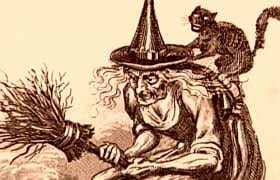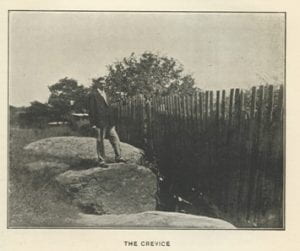In the spirit of Halloween, let’s learn more about one of the holidays most popular figures, the witch! What does the history of this crooked nosed, cauldron brewing, broomstick flying, black pointed hat character look like? What does witchcraft look like in historical and modern contexts?
The Book of Samuel 1 from the Bible, written between 931 B.C. and 721 B.C., contains one of the earliest mentions of a witch. To help defeat the Philistine army, the Witch of Endor is used by a King to summon the spirit of the prophet Samuel from the dead. The witch is able to do so, but the now alive Samuel prophesies the Kings death, as well as his sons, which comes to pass the very next day. Other bible verses from the Old Testament condemn witches and warn people not to take part in witchcraft or other related activities.
In the 11th century, the belief in witches and their abilities to fly was approached with skepticism rather than taken as fact. Bishop Burchard of Worms stated that, “Some wicked women, turning back to Satan and seduced by the illusions and phantasms of demons, believe [that] in the night hours they ride on certain animals with the pagan goddess Diana and a countless multitude of women, and they cross a great span of the world in the stillness of the dead of night.” While women were seen as more susceptible to demons during this time, men too were convicted of witchcraft.
 By the mid-1400s, in places like Europe, skepticism turned to facts, and fear took ahold as people looked for witches among themselves. The book “Malleus Maleficarum” or “The Hammer of Witches,” written in 1486 by two German Dominicans, most likely aided and spurred on the hunt for witches. The book enabled one to identify witches and pointed to women as more likely to be one. One passage reads, “Just as through the first defect in their [women’s] intelligence they are more prone to abjure the faith; so through their second defect of inordinate passions…they inflict various vengeances through witchcraft. Wherefore it is no wonder that so great a number of witches exist in this sex.” By the 16th century thousands, mostly women, were accused and killed on the basis of witchcraft throughout Europe.
By the mid-1400s, in places like Europe, skepticism turned to facts, and fear took ahold as people looked for witches among themselves. The book “Malleus Maleficarum” or “The Hammer of Witches,” written in 1486 by two German Dominicans, most likely aided and spurred on the hunt for witches. The book enabled one to identify witches and pointed to women as more likely to be one. One passage reads, “Just as through the first defect in their [women’s] intelligence they are more prone to abjure the faith; so through their second defect of inordinate passions…they inflict various vengeances through witchcraft. Wherefore it is no wonder that so great a number of witches exist in this sex.” By the 16th century thousands, mostly women, were accused and killed on the basis of witchcraft throughout Europe.
In the New World, witch hysteria also took root more into the 17th century, with the execution of Alse Young, the first person in America the be executed for witchcraft in 1647 in Windsor, Connecticut. Prior to the infamous Salem Witch Trials in 1692, in 1655 Lower Norfolk County in the state of Virginia actually passed a law that made it a crime to falsely accuse someone of witchcraft. While Virginia still had several witch trials from 1626 to 1730, no one was executed.
In contrast, the accused in Salem, Massachusetts numbered over 150. Nineteen people were hanged, both men and women, starting with Bridget Bishop on June 10th. Seven more died in jail, and a man named Giles Corey was pressed to death by stones during the trials, as well. As a quick note for archaeology: although Proctor’s Ledge was theorized to have been the location where the hangings took place in Salem according to historian Sidney Perley in 1921, in 2016, a team of researchers concluded this fact using GIS and an overlooked piece of testimony.
While external factors are believed to have played a larger role in Salem (fungus’ causing delusions and fits) thus intensifying witch mania in this town, not all of the new world was out on a witch hunt during the 17th and 18th century. The hysterics over witches declined as time passed and laws were put into place to protect people from being wrongly accused.
Today witchcraft is often practiced by Wiccans, and witches are portrayed in pop culture in movies and TV shows. From the cult-classic Hocus Pocus, to the terrifying The Witches, the beloved sitcom Bewitched, and the recently, re-imagined Chilling Adventures of Sabrina, witches are portrayed with a variety of personalities and agendas. While witch hunts are over, our fascination with this figure is not.
Hope you all have a spooky Halloween!
Follow IUP Anthropology on Facebook, Twitter, and Instagram

